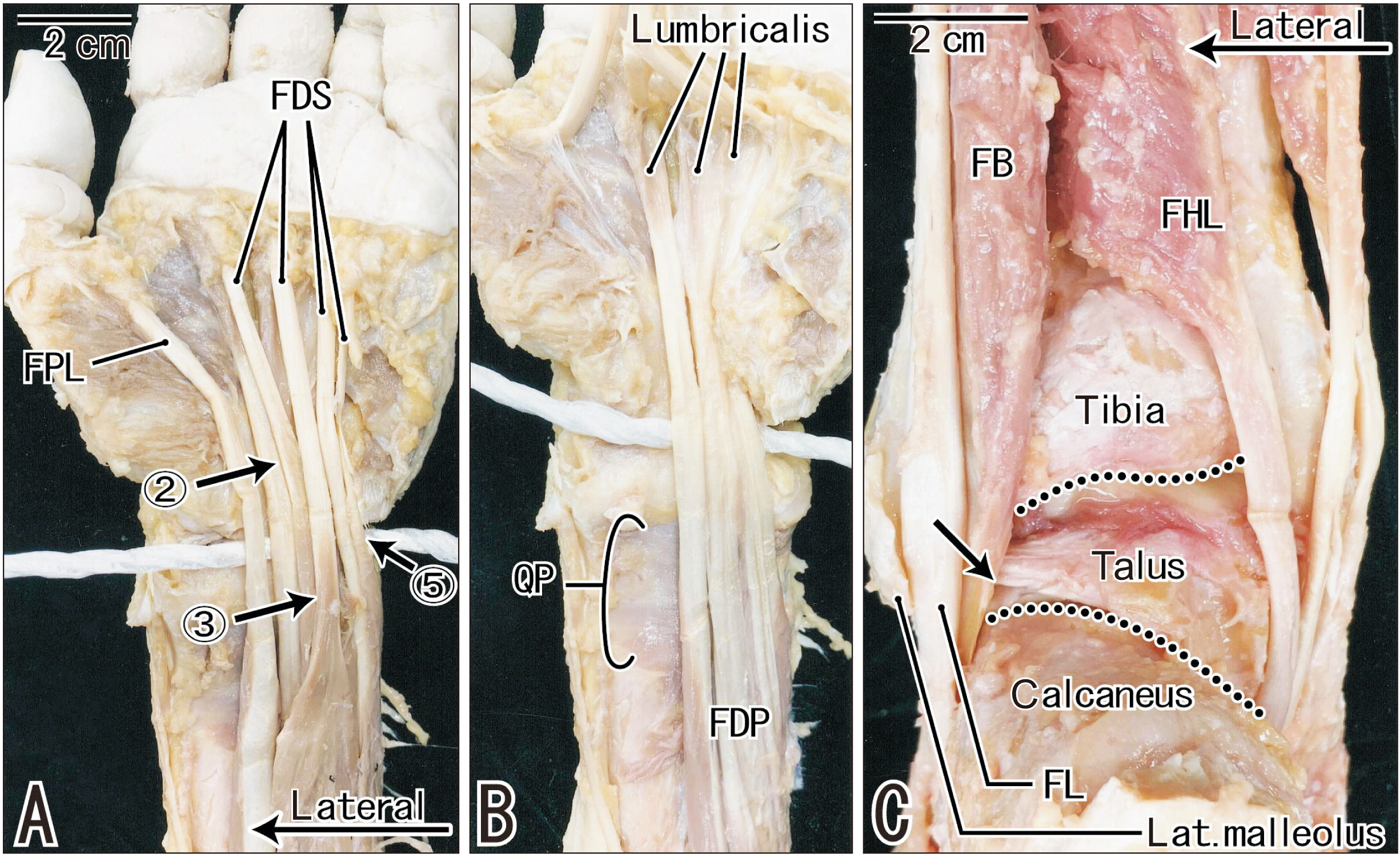Anat Cell Biol.
2023 Mar;56(1):46-53. 10.5115/acb.22.133.
Distally-extending muscle fibers across involved joints: study of long muscles and tendons of wrist and ankle in late-term fetuses and adult cadavers
- Affiliations
-
- 1Department of Anatomy, Wuxi School of Medicine, Jiangnan University, Wuxi, China
- 2Department of Anatomy, Division of Basic Medicine, Tokai University School of Medicine, Isehara, Kanagawa, Japan
- 3Department of Anatomy, Chonbuk National University Medical School, Jeonju, Korea
- 4Department of Anatomy, Tokyo Dental College, Tokyo, Japan
- 5Division of Internal Medicine, Cupid Clinic, Iwamizawa, Japan
- KMID: 2540984
- DOI: http://doi.org/10.5115/acb.22.133
Abstract
- It is unclear whether forearm and crural muscle fibers extend distally across the wrist and ankle joints, respectively. We hypothesized, in late-term fetuses, an over-production of muscle bellies extending over the joint. Muscle fibers in histological sections from unilateral wrists and ankles of 16 late-term fetuses (30–40 weeks) were examined and compared with 15 adult cadavers. Muscle fibers of the flexor digitorum profundus (FDP) and flexor digitorum superficialis (FDS) in fetuses, especially muscle bellies to the third and fourth fingers, were found to extend far distally beyond the radiocarpal joint. The extensor digitorum and extensor pollicis longus on the extensor side of the wrist were found to carry distally-extending muscle fibers, but these fibers did not extend beyond the distal end of the radius. In the ankle, most muscle bundles in the flexor hallucis longus (FHL), fibularis brevis (FB) and extensor digitorum longus extended distally beyond the talocrural joint, with most FB muscle fibers reaching the level of the talocalcaneal joint. In adult cadavers, muscle fibers of the FDP and FHL did not reach the levels of the radiocarpal and talocrural joints, respectively, whereas the FB muscle belly always reached the talocalcaneal joint. Similarly, some of the FDS reached the level of the radiocarpal joint. Generally, infants’ movements at the wrist and ankle could result in friction injury to over-extended muscle. However, the calcaneal and FDP tendons might protect the FB and FDS tendons, respectively, from friction stress.
Keyword
Figure
Reference
-
References
1. Spinner M. 1978. Injuries to the major branches of peripheral nerves of the forearm. 2nd ed. Saunders;Philadelphia:2. Neumeister MW, Mowlavi A, Russell RC, Wilhelmi BJ. 2005; Anomalous flexor digitorum superficialis muscle transposition for vascular coverage of the median nerve in recurrent carpal tunnel syndrome. Can J Plast Surg. 13:27–30. DOI: 10.1177/229255030501300102. PMID: 24222998. PMCID: PMC3822475.
Article3. Tubbs RS, Yablick MW, Loukas M, Shoja MM, Ardalan M, Oakes WJ. 2008; Capsular attachment of the brachialis muscle (Portal's muscle): an anatomical and functional study. Surg Radiol Anat. 30:229–32. DOI: 10.1007/s00276-008-0312-y. PMID: 18253690.
Article4. Sanal HT, Chen L, Negrao P, Haghighi P, Trudell DJ, Resnick DL. 2009; Distal attachment of the brachialis muscle: anatomic and MRI study in cadavers. AJR Am J Roentgenol. 192:468–72. DOI: 10.2214/AJR.08.1150. PMID: 19155412.
Article5. Jin ZW, Jin Y, Yamamoto M, Abe H, Murakami G, Yan TF. 2016; Oblique cord (chorda obliqua) of the forearm and muscle-associated fibrous tissues at and around the elbow joint: a study of human foetal specimens. Folia Morphol (Warsz). 75:493–502. DOI: 10.5603/FM.a2016.0019. PMID: 27830875.
Article6. Abe S, Aoki M, Nakao T, Kasahara M, Rodriguez-Vazquez JF, Murakami G, Cho BH. 2014; Variation of the subscapularis tendon at the fetal glenohumeral joint. Okajimas Folia Anat Jpn. 90:89–95. DOI: 10.2535/ofaj.90.89. PMID: 24815107.
Article7. Muraki T, Aoki M, Uchiyama E, Takasaki H, Murakami G, Miyamoto S. 2007; A cadaveric study of strain on the subscapularis muscle. Arch Phys Med Rehabil. 88:941–6. DOI: 10.1016/j.apmr.2007.04.003. PMID: 17601478.
Article8. Jin ZW, Kim JH, Suzuki D, Sugai N, Murakami G, Abe H, Rodríguez-Vázquez JF. 2021; Relationship of the fabella with the origins of the plantaris and gastrocnemius lateral head muscles in late-term fetuses: a histological study. Anat Cell Biol. 54:270–9. DOI: 10.5115/acb.20.326. PMID: 33896799. PMCID: PMC8225468.
Article9. Tidball JG. 1992; Desmin at myotendinous junctions. Exp Cell Res. 199:206–12. DOI: 10.1016/0014-4827(92)90425-8. PMID: 1544366.
Article10. Carlsson L, Li Z, Paulin D, Thornell LE. 1999; Nestin is expressed during development and in myotendinous and neuromuscular junctions in wild type and desmin knock-out mice. Exp Cell Res. 251:213–23. DOI: 10.1006/excr.1999.4569. PMID: 10438587.
Article11. Trotter JA. 1993; Functional morphology of force transmission in skeletal muscle. A brief review. Acta Anat (Basel). 146:205–22. DOI: 10.1159/000147459. PMID: 8317197.12. Huijing PA. 1999; Muscle as a collagen fiber reinforced composite: a review of force transmission in muscle and whole limb. J Biomech. 32:329–45. DOI: 10.1016/S0021-9290(98)00186-9. PMID: 10213024.
Article
- Full Text Links
- Actions
-
Cited
- CITED
-
- Close
- Share
- Similar articles
-
- Influence of developing ligaments on the muscles in contact with them: a study of the annular ligament of the radius and the sacrospinous ligament in mid-term human fetuses
- Insertions of the striated muscles in the skin and mucosa: a histological study of fetuses and cadavers
- Distribution of elastic fibers in the head and neck: a histological study using late-stage human fetuses
- Striated muscle fiber crossings of the head and neck: a histological study using near-term human fetuses and elderly cadavers
- MR Image Findings of Giant Cell Tumor of the Tendon Sheath Involving the Foot: A Case Report






